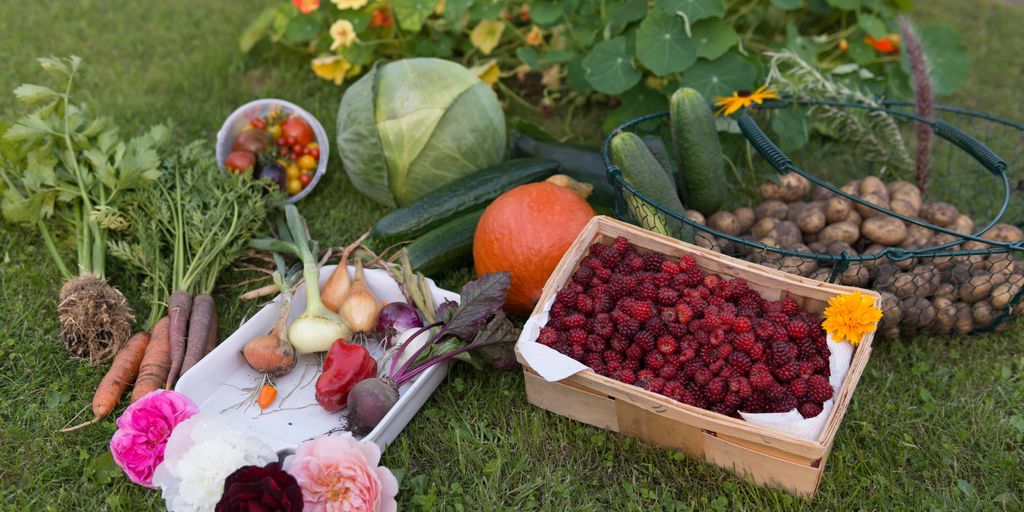
1. Organic Gardening

Embrace the essence of sustainable living through organic gardening, a method that nurtures not only the plants but also the ecosystem around them. Organic gardening is about more than just avoiding chemicals; it’s a holistic approach to gardening that emphasizes the health of the soil, the water, and the biodiversity of the garden environment.
Key Techniques in Organic Gardening
- Soil health: Start with enriching the soil naturally using compost and other organic matter.
- Pest management: Utilize natural predators and barriers to keep pests at bay without harmful chemicals.
- Crop rotation: Enhance soil nutrients and prevent disease by rotating crops seasonally.
- Water conservation: Implement drip irrigation and rainwater harvesting to minimize water usage.
Organic gardening is a commitment to growing food in harmony with nature, ensuring a sustainable future for our planet.
2. Composting Basics

Composting is a cornerstone of sustainable living, transforming kitchen scraps and yard waste into nutrient-rich soil that can invigorate your garden. It’s not only about waste reduction but also about enhancing the health of your garden ecosystem. Here are some essential tips to get you started:
- Choose the right location: Your compost bin should be easily accessible yet out of direct sunlight.
- Balance your greens and browns: Greens are nitrogen-rich materials like vegetable scraps, and browns are carbon-rich materials like dried leaves. A good balance between these will ensure your compost breaks down effectively.
- Turn your pile regularly: This helps aerate the compost and speeds up the decomposition process.
- Keep it moist: Your compost should be damp, but not wet, to foster the right microbial environment.
Embrace composting as a simple step towards a more sustainable lifestyle and a healthier garden.
By integrating these practices, you can create a vibrant, self-sustaining garden that not only supports your cooking needs but also contributes to a healthier planet.
3. Seasonal Eating

Embracing seasonal eating is not just a culinary choice but a lifestyle that enhances your health and supports the local economy. By aligning your diet with the rhythm of nature, you ensure that you’re consuming fruits and vegetables at their peak of freshness and nutritional value. This practice not only promises a variety of textures and tastes but also minimizes the environmental impact of food transport.
Seasonal eating helps you reconnect with the natural cycles of the earth, fostering a deeper appreciation for the ingredients and the processes involved in their cultivation.
Here are some benefits of seasonal eating:
- Fresher, tastier ingredients: Foods grown in their appropriate season are more likely to be harvested at their peak and sold shortly after.
- Enhanced nutritional value: Seasonal produce can be richer in nutrients compared to off-season counterparts that require long distances for transport.
- Support for local farmers: Buying seasonal supports local farmers and producers, reducing the need for long-haul transportation.
- Economic benefits: Seasonal foods often cost less when they are in abundance.
By incorporating seasonal foods into your meals, you not only enjoy fresher, more delicious food but also contribute to a sustainable food system that benefits everyone involved.
4. Farm-to-Table Dining

Embracing the farm-to-table dining experience is about more than just enjoying a meal; it’s a celebration of local agriculture and a commitment to sustainability. This dining concept thrives on the partnership between restaurants and local farms, aiming to serve the freshest and most seasonal ingredients available. By sourcing ingredients directly from local farmers, restaurants ensure not only the quality but also the traceability of the food on your plate.
Why Choose Farm-to-Table?
Choosing a farm-to-table restaurant means supporting local farmers and reducing the carbon footprint associated with long-distance food transportation. This approach helps in preserving the environment and boosting the local economy.
How to Identify Authentic Farm-to-Table Restaurants
When looking for an authentic farm-to-table experience, consider these factors:
- Proximity: The closer the restaurant is to its suppliers, the fresher the ingredients.
- Seasonality: Menus that change with the seasons are a good sign of true farm-to-table practices.
- Transparency: Restaurants that openly share information about their suppliers and farming practices are more likely to be genuine.
Benefits of Farm-to-Table Dining
The benefits of this dining concept extend beyond just taste and freshness. It promotes a healthier lifestyle and creates a deeper connection between the diner and the origin of their food. By choosing farm-to-table, you are part of a movement that values food integrity and environmental stewardship.
5. Herbal Infusions

Herbal infusions are a delightful and easy way to embrace whole foods for vibrant health. By steeping fresh or dried herbs in hot water, you can extract a wide range of beneficial compounds that promote well-being and vitality. Herbal teas, as they are commonly known, are not only soothing but also packed with antioxidants, vitamins, and minerals.
Herbal infusions can be tailored to suit your taste and health needs, making them a versatile addition to your daily routine.
Here are some popular herbs and their known benefits:
- Chamomile: Soothes the digestive system and helps with sleep.
- Peppermint: Enhances digestion and relieves headaches.
- Ginger: Boosts immunity and combats inflammation.
- Hibiscus: Lowers blood pressure and supports liver health.
Incorporating herbal infusions into your diet is a simple way to increase your intake of fluids and nutrients, supporting overall health and hydration. Remember, the key to benefiting from herbal infusions is consistency and variety, ensuring you receive a broad spectrum of nutrients.
6. Fermentation Techniques

Fermentation is not just a culinary trend; it’s an ancient practice that has been revitalized in modern kitchens for its health benefits and unique flavors. The art of food fermentation involves a magical transformation where natural bacteria feed on sugars and starches, creating lactic acid. This process not only preserves the food but also creates beneficial enzymes, b-vitamins, omega-3 fatty acids, and various strains of probiotics.
Natural fermentation can help improve digestion, boost immunity, and increase energy levels. Here’s a simple guide to get started:
- Choose your base (vegetables, fruits, dairy, etc.)
- Prepare and cut your base into consistent sizes.
- Add salt or a starter culture to initiate fermentation.
- Ensure the mixture is anaerobic (without oxygen) by sealing it in a container.
- Allow it to ferment at room temperature for a period depending on the recipe.
- Taste and store in a cool place.
Embrace the process of fermentation to not only enhance the flavor of your meals but also to contribute to a healthier lifestyle.
7. Sprouting at Home

Sprouting at home is a simple, cost-effective way to enhance your diet with high-nutrient seeds. The process involves germinating seeds to be eaten raw or cooked, which can significantly boost their nutritional value. Sprouting can be done with a variety of seeds, including alfalfa, radish, and mung beans.
Sprouting doesn’t require a green thumb, just a few simple tools and some patience.
Here’s a basic guide to get you started:
- Choose the right seeds: Opt for organic and untreated seeds to ensure they are safe for sprouting.
- Soaking: Place the seeds in a clean Mason jar, cover with cool water, and soak them overnight.
- Rinsing and Draining: Rinse the seeds several times a day and ensure they are well-drained to prevent mold.
- Harvesting: Most sprouts are ready to eat within 3-5 days. Once they’re grown, rinse them thoroughly and store in the refrigerator.
Incorporating sprouts into your meals can be a delightful experience. They add a fresh, crunchy texture to salads, sandwiches, and even smoothies. By sprouting at home, you’re taking a step towards a more sustainable and health-conscious lifestyle.
8. Mindful Cooking

Mindful cooking is not just about preparing meals but about transforming the cooking process into a meditative practice that nourishes both body and soul. It involves being fully present in the moment, from selecting ingredients to the act of cooking itself. By embracing mindful cooking, you engage all your senses, enhancing the experience and the flavor of the food.
- Select fresh ingredients: Opt for fresh, quality ingredients that inspire you.
- Focus on the process: Pay attention to each step, from chopping to seasoning.
- Savor each bite: When eating, truly taste and enjoy each mouthful.
Mindful cooking encourages a deeper connection to the food we eat and the world around us. It’s a practice that fosters appreciation and gratitude for the nourishment provided.
By integrating mindfulness into your cooking routine, you can turn everyday meals into a source of joy and relaxation, making each meal an opportunity for personal growth and happiness.
9. Whole Foods Diet

Embracing a Whole Foods Diet is not just about choosing to eat healthier; it’s about making a lifestyle change that benefits both the body and the planet. This comprehensive guide to healthy eating emphasizes the importance of integrating nutrient-dense, unprocessed foods into your daily regimen.
Benefits of a Whole Foods Diet
A whole foods diet is rich in fruits, vegetables, whole grains, and lean proteins, which are crucial for maintaining optimal health. Here are some key benefits:
- Enhanced overall health through improved nutrient intake
- Reduced risk of chronic diseases such as heart disease, diabetes, and cancer
- Increased energy levels and improved mood
How to Transition to a Whole Foods Diet
Starting a whole foods diet can seem daunting, but with a few simple steps, you can make the transition smoothly:
- Begin by incorporating more fruits and vegetables into your meals.
- Swap out refined grains for whole grains like brown rice and quinoa.
- Choose lean proteins and plant-based alternatives.
- Gradually reduce the intake of processed foods.
Embrace this change at your own pace and adjust according to your dietary needs and preferences.
Shopping and Dining Out
Smart shopping and making wise choices while dining out are crucial for maintaining a whole foods diet. Here are some tips for navigating supermarkets and dining out:
- Always read labels to ensure products are free from excessive additives and sugars.
- Opt for local and organic produce whenever possible.
- When dining out, choose dishes that are steamed, grilled, or baked rather than fried.
By prioritizing nutrient-dense choices, you can enjoy vibrant meals that are not only delicious but also nourishing to your body and soul.
10. Local Farmers’ Markets

Exploring your local farmers’ market is more than just a shopping trip; it’s a vibrant journey into the heart of your community’s agriculture. Discover the joys of midweek markets and the unique offerings each stall holds. From the freshest fruits and vegetables to artisanal cheeses, homemade jams, and freshly baked bread, the variety is astounding.
Farmers’ markets not only offer an array of delights but also foster a connection between the consumer and the source of their food. By supporting these markets, you’re not only getting nutritional produce but also contributing to the local economy and encouraging sustainable practices.
Here are some reasons to visit your local farmers’ market:
- Experience a treasure trove of fresh produce alongside unique items like local wines and kombucha.
- Engage with farmers to learn more about how your food is grown.
- Enjoy seasonal specialties that supermarkets may not offer.
- Participate in community events and food festivals that often accompany market days.
Embrace the opportunity to transform your shopping into an enriching experience that benefits both your palate and your community.
Conclusion
In the journey from soil to soul, the techniques we choose to cultivate, prepare, and enjoy our food can transform our meals from mere sustenance to vibrant experiences that nourish both body and spirit. Embracing the best practices for fresh and vibrant meals not only enhances our health but also deepens our connection to the earth and its bounty. As we continue to explore and implement these techniques, we invite a richness into our lives that goes beyond the plate, fostering a sense of well-being and joy in every bite. Let us cherish each meal as an opportunity to nourish our souls and celebrate the natural beauty of our world.







1 thought on “Nourishment from Soil to Soul: Best Techniques for Fresh and Vibrant Meals”
Comments are closed.